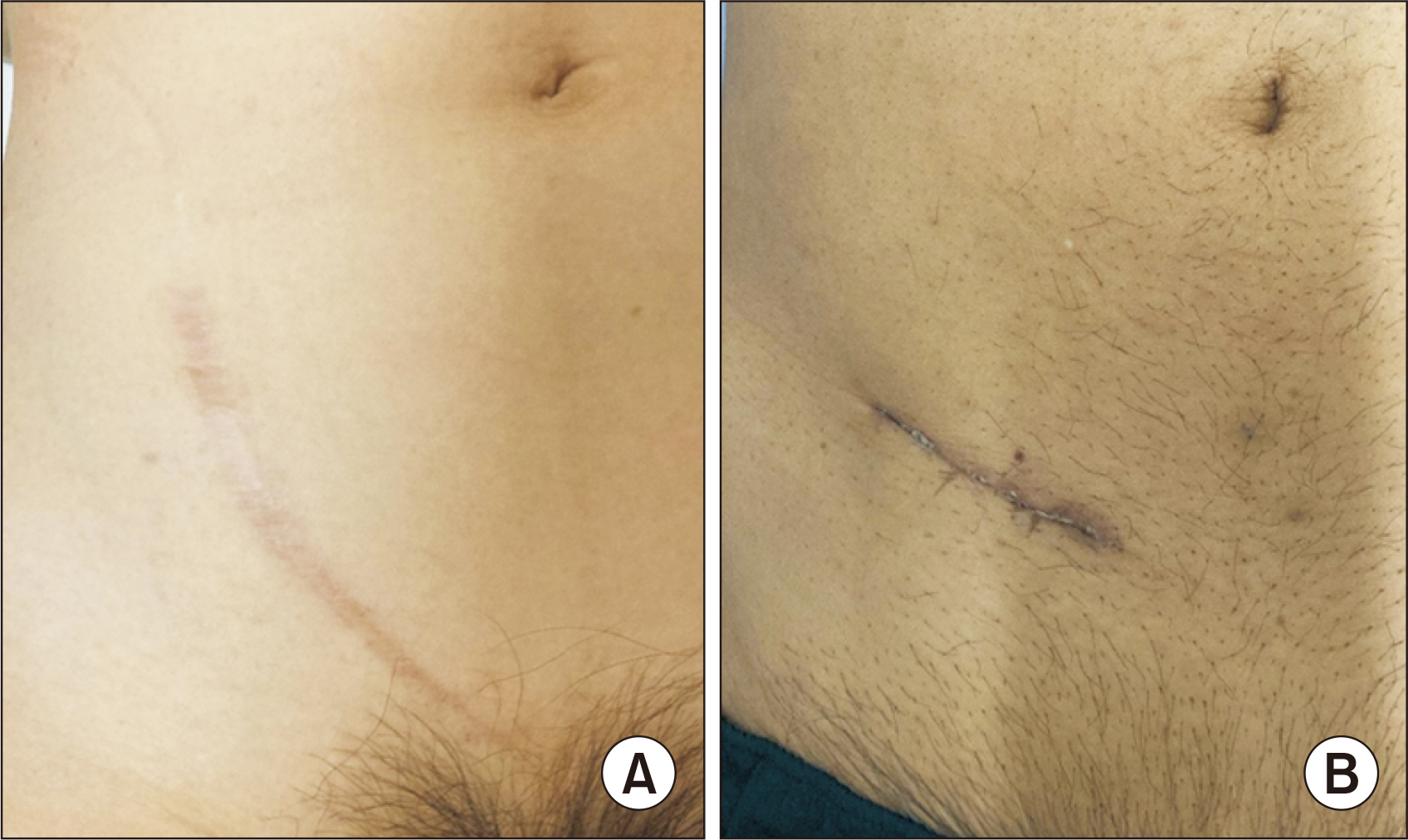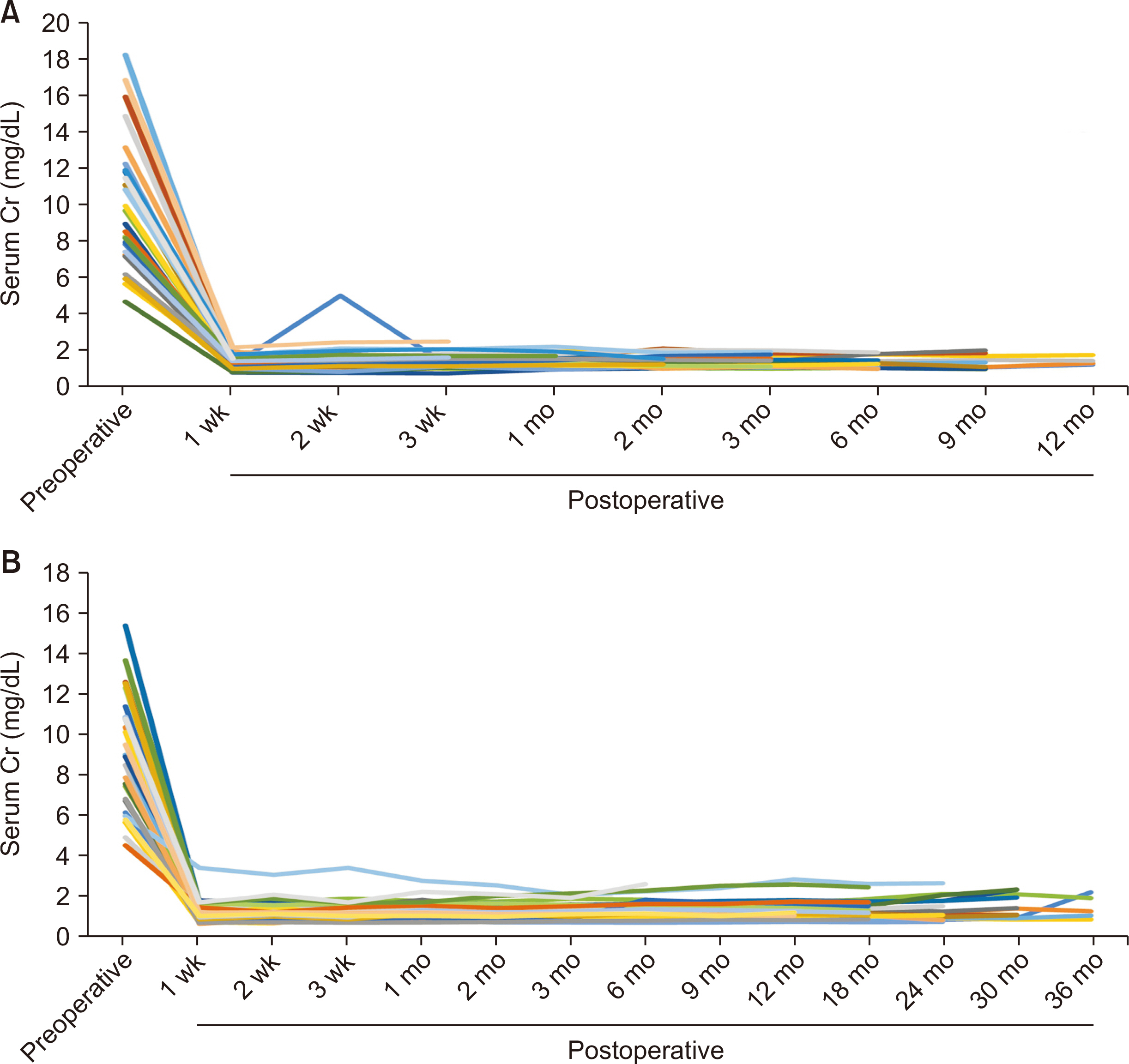Korean J Transplant.
2023 Sep;37(3):165-169. 10.4285/kjt.23.0022.
Minimally invasive recipient procedure in kidney transplantation
- Affiliations
-
- 1Department of Surgery, Miyazaki Prefectural Hospital, Miyazaki, Japan
- 2Department of Nephrology, Miyazaki Prefectural Hospital, Miyazaki, Japan
- 3Recipient Coordinator, Miyazaki Prefectural Hospital, Miyazaki, Japan
- KMID: 2546474
- DOI: http://doi.org/10.4285/kjt.23.0022
Abstract
- Background
There are several procedural variations for kidney transplant donors, including open, laparoscopic, hand-assisted, and robotic methods, with either an intra- abdominal or retroperitoneal approach. Conversely, fewer options are available for the recipient procedure. We introduce a method that involves a small incision, with the goal of being less invasive for recipients.
Methods
Our current method was introduced in April 2022. As of July 2023, we have completed 27 cases. We analyzed several factors in these 27 cases, including the size of the incision, rewarming time, anastomosis time, graft function, analgesic use, and complications.
Results
The average incision size was 73 mm. The time taken for anastomosis was 24. 1 minutes, while the rewarming time averaged 43.1 minutes. There were no instances of primary nonfunction. One case necessitated postoperative dialysis three times due to heart failure. Following stent removal, one patient developed grade 1 hydronephrosis. There was one instance of bleeding from the drain insertion site. Another case involved a clamp injury to the external iliac artery, which necessitated stent insertion on the fourth postoperative day. Compared to procedures performed using conventional methods, the use of analgesics was less in these cases.
Conclusions
Our minimally invasive technique, which involves a small incision, is a feasible alternative that could potentially be less invasive than traditional methods.
Keyword
Figure
Reference
-
1. Wagenaar S, Nederhoed JH, Hoksbergen AW, Bonjer HJ, Wisselink W, van Ramshorst GH. 2017; Minimally invasive, laparoscopic, and robotic-assisted techniques versus open techniques for kidney transplant recipients: a systematic review. Eur Urol. 72:205–17. DOI: 10.1016/j.eururo.2017.02.020. PMID: 28262412.2. Øyen O, Scholz T, Hartmann A, Pfeffer P. 2006; Minimally invasive kidney transplantation: the first experience. Transplant Proc. 38:2798–802. DOI: 10.1016/j.transproceed.2006.08.102. PMID: 17112833.3. Spiers HV, Sharma V, Woywodt A, Sivaprakasam R, Augustine T. 2021; Robot-assisted kidney transplantation: an update. Clin Kidney J. 15:635–43. DOI: 10.1093/ckj/sfab214. PMID: 35371439. PMCID: PMC8967665.4. Haberal M, Boyvat F, Akdur A, Kırnap M, Özçelik Ü, Yarbuğ Karakayalı F. 2016; Surgical complications after kidney transplantation. Exp Clin Transplant. 14:587–95.5. Gioco R, Sanfilippo C, Veroux P, Corona D, Privitera F, Brolese A, et al. 2021; Abdominal wall complications after kidney transplantation: a clinical review. Clin Transplant. 35:e14506. DOI: 10.1111/ctr.14506. PMID: 34634148. PMCID: PMC9285099.6. Ozmen MM, Bilgic I, Ziraman I, Koc M. 2013; Torsion of extraperitoneally transplanted kidney: an unusual complication. Exp Clin Transplant. 11:186–90. DOI: 10.6002/ect.2012.0089. PMID: 23075049.7. Winter TC, Clarke AL, Campsen J. 2013; Acute torsion of a retroperitoneal renal transplant mimicking renal vein thrombosis. Ultrasound Q. 29:203–4. DOI: 10.1097/RUQ.0b013e31829d35cf. PMID: 23867571.8. Lucewicz A, Isaacs A, Allen RD, Lam VW, Angelides S, Pleass HC. 2012; Torsion of intraperitoneal kidney transplant. ANZ J Surg. 82:299–302. DOI: 10.1111/j.1445-2197.2011.05792.x. PMID: 22507693.
- Full Text Links
- Actions
-
Cited
- CITED
-
- Close
- Share
- Similar articles
-
- Minimally Invasive Video-Assisted Kidney Transplantation
- Visualizing kidney transplant techniques: a comparative study of open and robotic surgery
- Successful treatment of symptomatic lymphocele after kidney transplantation
- Evaluation of the Recipient and Donor in Living Kidney Transplantation
- A New Beginning for the Journal of Minimally Invasive Surgery for the International Recognition and Contribution of Scientific Development of Minimally Invasive Surgery



